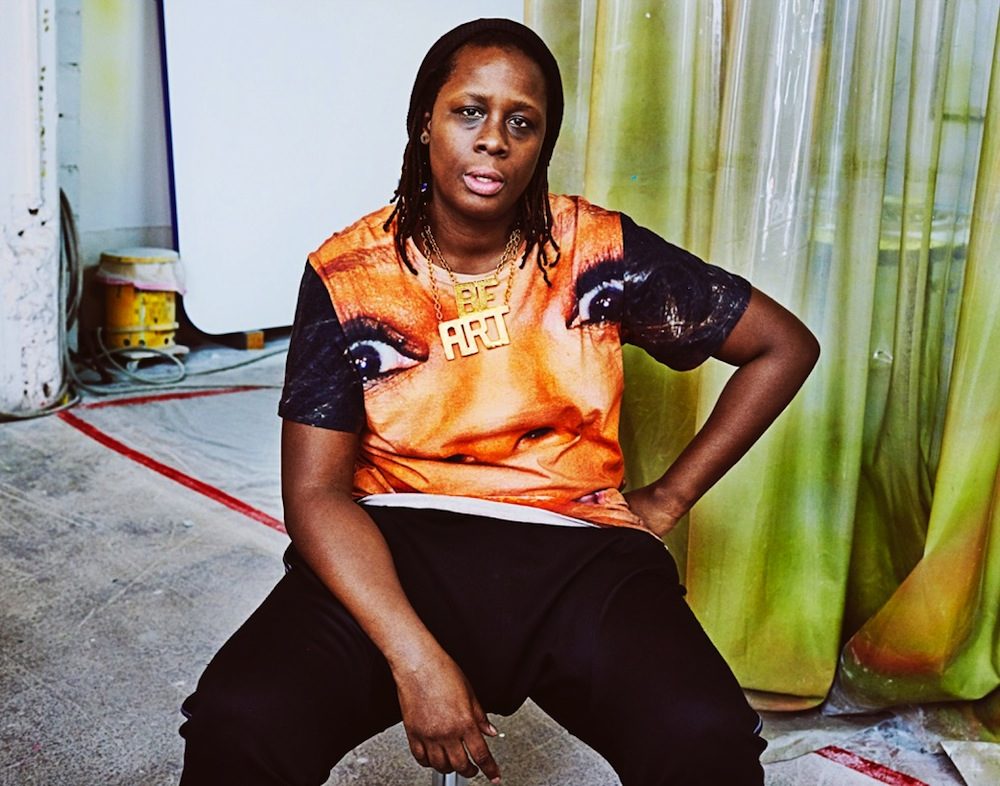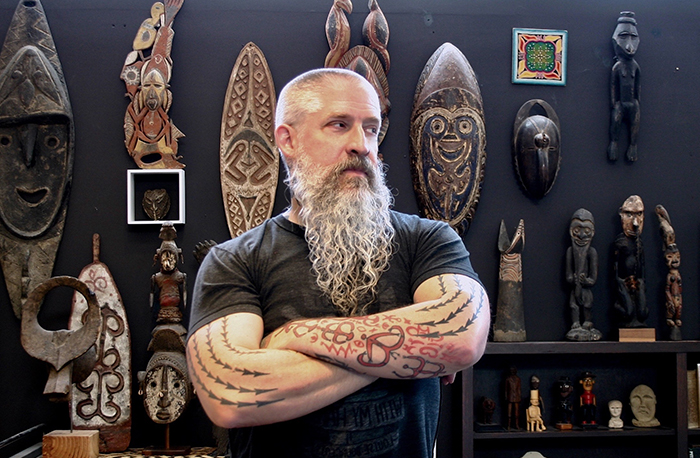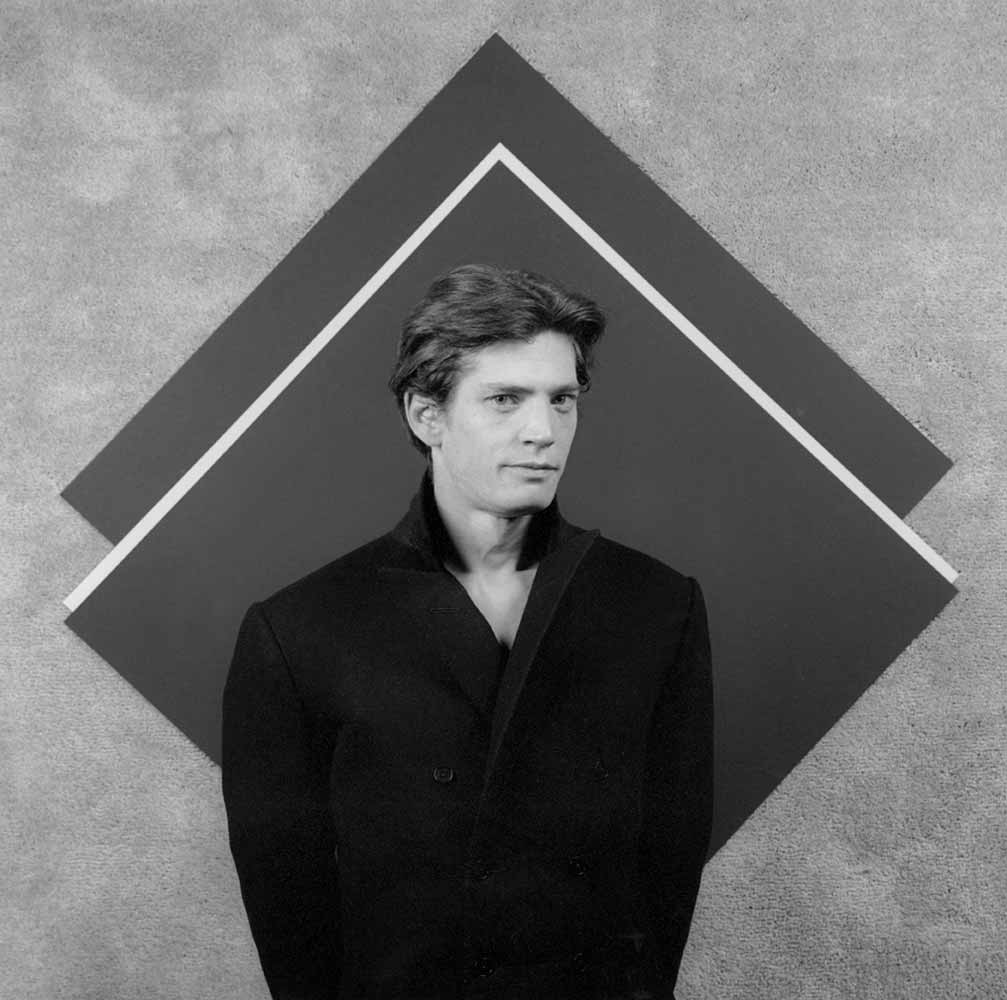LGBT Artists Leaving an Indelible Mark

LGBT artists have continually challenged mainstream understandings of gender and sexuality. The impact of this on our society is immeasurable. For example, artists of the 1980s who worked tirelessly to bring attention to HIV/AIDS in America, artists today maintain their roles as leading figures striving for change and cultural awareness. On that note, here are a few LGBT artists who have influenced the progress of art and society.
Here is just a glimpse of some of the many creative individuals who as members of the LGBT community have put their unique stamp on art history. These amazing LGBT artists have assuredly changed the art world and beyond with their work.

Mickalene Thomas
New York based artist Mickalene Thomas is best known for her elaborate paintings composed of rhinestones, acrylic and enamel. Thomas introduces a complex vision of what it means to be a woman and expands common definitions of beauty. Her work stems from her long study of art history and the classical genres of portraiture, landscape, and still life. Inspired by various sources that range from the 19th century Hudson River School to Édouard Manet, Henri Matisse and Romare Bearden, she continues to explore notions of beauty from a contemporary perspective infused with the more recent influences of popular culture and pop art.

Felix Gonzalez-Torres
Felix Gonzalez-Torreswas an American, Cuban-born, gay visual artist. González-Torres was known for his quiet, minimal installations and sculptures. Using materials such as strings of lightbulbs, clocks, stacks of paper, or packaged hard candies, his work is sometimes considered a reflection of his experience with AIDS. In 1987 he joined Group Material, a New York-based group of artists whose intention was to work collaboratively, adhering to principles of cultural activism and community education. Along with the other members of the group — Doug Ashford, Julie Ault, Karen Ramspacher, and Tim Rollins — González-Torres was invited by the MATRIX Gallery at the Berkeley Art Museum and Pacific Film Archive in 1989 to deal with the subject of AIDS.

David Hockney
Born in Bradford, England, in 1937, David Hockney attended art school in London before moving to Los Angeles in the 1960s. There, he painted his famous swimming pool paintings. In the 1970s, Hockney began working in photography, creating photo collages he called joiners. Hockney’s early paintings incorporated his literary leanings, and he used fragments of poems and quotations from Walt Whitman in his work. This practices, and paintings such as We Two Boys Clinging Together, which he created in 1961, were the first nods to his homosexuality in his art. He continues to create and exhibit art, and in 2011 he was voted the most influential British artist of the 20th century.

Rotimi Fani-Kayode
A seminal figure in 1980s black British and African contemporary art, Fani-Kayode’s timeless photographs constitute a profoundly personal and political exploration of complex notions of desire, diaspora, and spirituality. Ancestral rituals and a provocative, multi-layered symbolism fuse with archetypal motifs from European and African cultures and subcultures – inspired by what Yoruba priests call ‘the technique of ecstasy’. A son of a prominent Yoruba family who left Africa as political refugees in 1966, Fani-Kayode received a BA at Georgetown University in Washington, DC in 1980, and an MFA at Pratt Institute in New York in 1983, before returning to the United Kingdom where he lived and worked until his death in 1989.

Aaron Smith
Aaron Smith is known for referencing art history in both his painting style and compositions. His new paintings’ color and surfaces are liberated of historic constraints. By taking such liberties with the images’ presentation, the artist transforms still life paintings into uniquely contemporary symbolic portraits. Derived from opulent objects; Gothic and Baroque sculpture originally created to spiritually inspire; the paintings strip the all-male characters of context, suspending them in an existential vacuum. His figurative oil paintings have earned him solo shows at some of LA and Chicago’s finer galleries.

Jeanne Mammen
Jeanne Mammen is one of the most impressive, unusual and versatile German female artists of the twentieth century. She is frequently mentioned in connection with Käthe Kollwitz and Hanna Höch, two artists who also showed a strong engagement in social emancipation, and whose most successful years also date to the Weimar era. When comparing Jeanne Mammen to other socially critical male artists of the time, like Otto Dix and George Grosz, a certain resemblance in the selected motifs can be noticed, but there is quite a difference in their vision and style of portrayal. In contrast to Dix and Grosz, Jeanne Mammen’s pictorial statement regarding injustice and the ensuing deplorable social conditions is neither marked by harsh denouncement, nor does it convey pity, and her portrayal of the Bourgeois is without biting malice and condescension. She is the only artist of her time, who, by using her intuitive power and her penetrating eyes, succeeded in delivering precise and cunning portrayals capturing the characteristic physiognomic features, typical of people of all walks of life in the 1930s.

Keith Haring
Throughout his career, Haring devoted much of his time to public works, which often carried social messages. He produced more than 50 public artworks between 1982 and 1989, in dozens of cities around the world, many of which were created for charities, hospitals, children’s day care centers and orphanages. The now famous Crack is Wack mural of 1986 has become a landmark along New York’s FDR Drive. Other projects include; a mural created for the 100th anniversary of the Statue of Liberty in 1986, on which Haring worked with 900 children; a mural on the exterior of Necker Children’s Hospital in Paris, France in 1987; and a mural painted on the western side of the Berlin Wall three years before its fall. Haring also held drawing workshops for children in schools and museums in New York, Amsterdam, London, Tokyo and Bordeaux, and produced imagery for many literacy programs and other public service campaigns.
Haring was diagnosed with AIDS in 1988. In 1989, he established the Keith Haring Foundation, its mandate being to provide funding and imagery to AIDS organizations and children’s programs, and to expand the audience for Haring’s work through exhibitions, publications and the licensing of his images. Haring enlisted his imagery during the last years of his life to speak about his own illness and generate activism and awareness about AIDS. Keith Haring died of AIDS related complications at the age of 31 in February 1990.

Robert Mapplethorpe
In the late 70s, Mapplethorpe grew increasingly interested in documenting the New York S & M scene. The resulting photographs are shocking for their content and remarkable for their technical and formal mastery. Mapplethorpe told ARTnews in late 1988, “I don’t like that particular word ‘shocking.’ I’m looking for the unexpected. I’m looking for things I’ve never seen before … I was in a position to take those pictures. I felt an obligation to do them.” Meanwhile his career continued to flourish. In 1977, he participated in Documenta 6 in Kassel, West Germany and in 1978, the Robert Miller Gallery in New York City became his exclusive dealer. Throughout the 80s, Mapplethorpe produced a bevy of images that simultaneously challenge and adhere to classical aesthetic standards: stylized compositions of male and female nudes, delicate flower still lifes, and studio portraits of artists and celebrities, to name a few of his preferred genres. He introduced and refined different techniques and formats, including color 20″ x 24″ Polaroids, photogravures, platinum prints on paper and linen, Cibachrome and dye transfer color prints. His vast, provocative, and powerful body of work has established him as one of the most important artists of the twentieth century.

Mel Odom
Finding order from chaos, beauty within pain, and hope from despair, the artist Mel Odom’s career has spanned several of our generation’s most tumultuous cultural decades. His innate ability to process, through his work, the events surrounding him and his life are viscerally transformed into a dream-like state of bliss in his art and in his creation of memorable objects of desire.
Written by Chris Astrala
This article appeared originally in The Standard Palm Springs, read more at thestandardps.com






